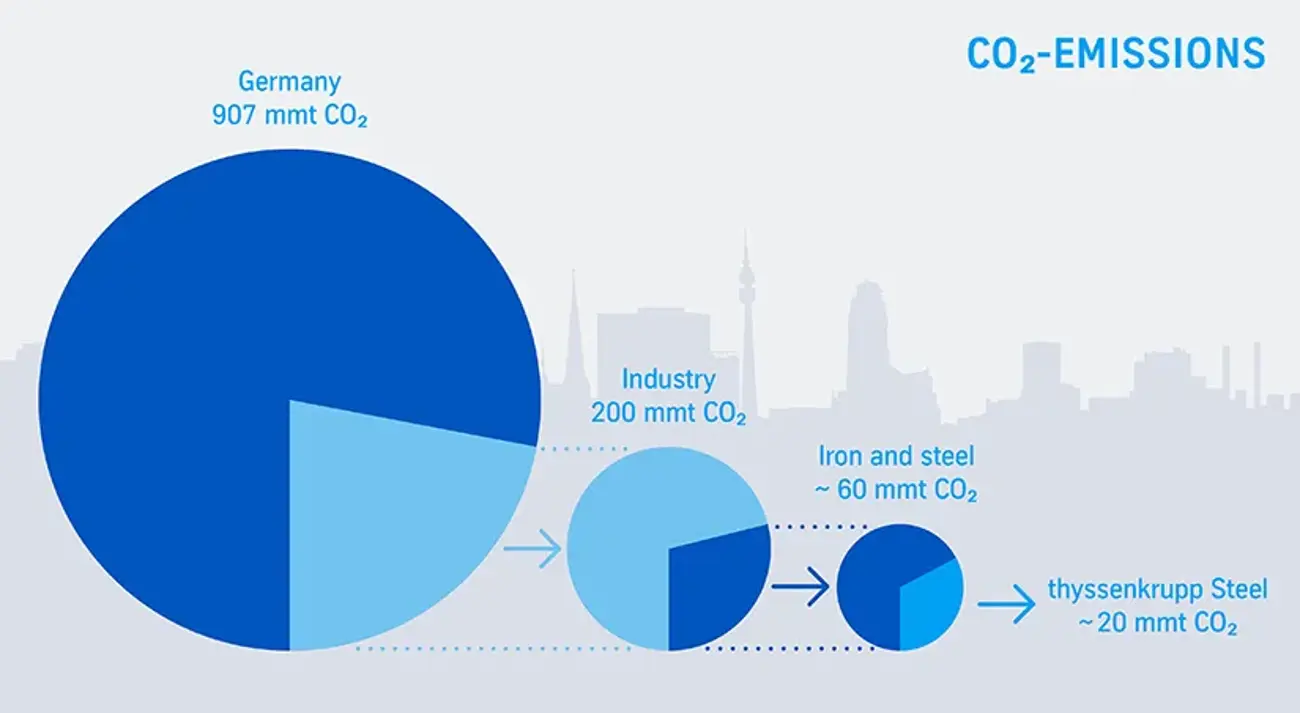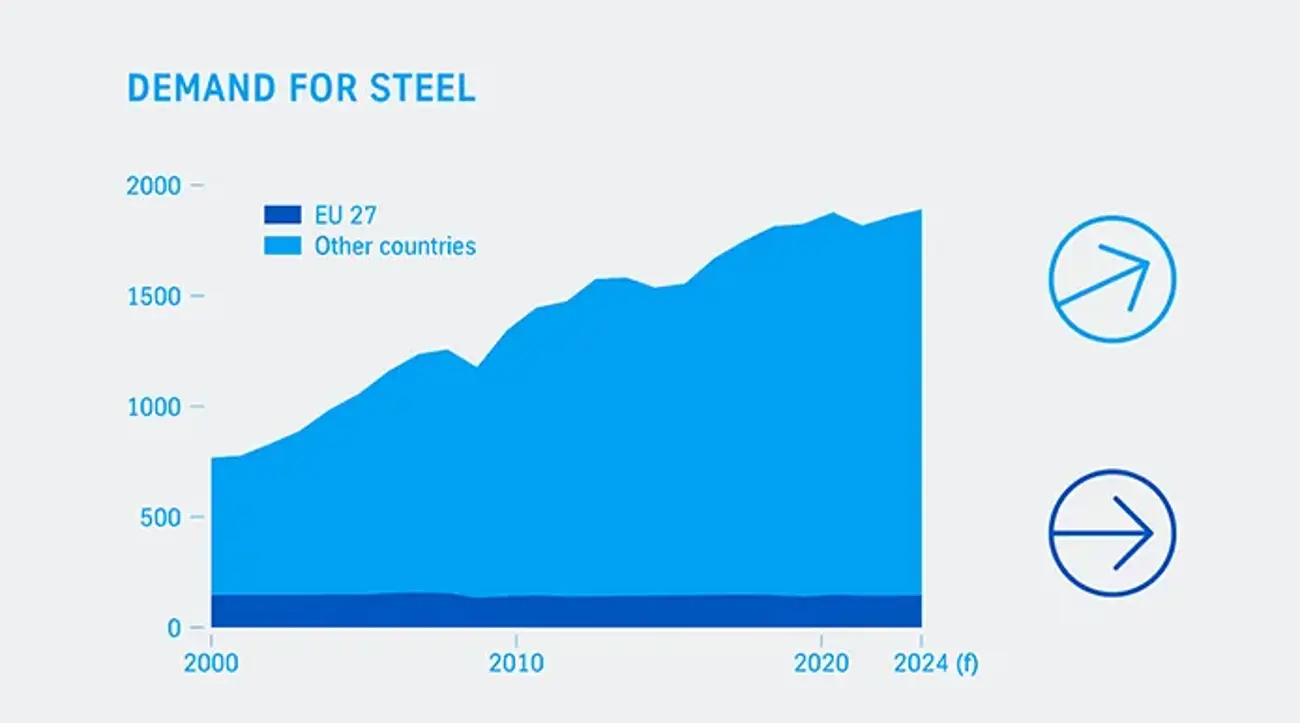At around 20 million metric tons, thyssenkrupp Steel accounts for 2.5% of Germany's CO2 emissions. Source: Agora energy turnaround: UBA, 2019a; WV Stahl, 2018; Wuppertal Institute, 2019; own calculations
The challenges and responsibility of the steel industry for a carbon-neutral future
The steel industry bears an enormous responsibility for climate change mitigation. At around 20 million metric tons, thyssenkrupp Steel accounts for 2.5% of Germany's CO2 emissions. This illustrates the immense impact that steelmaking imposes on the environment. Overall, the steel industry accounts for around 7% of Germany's CO2 emissions, and thyssenkrupp Steel contributes about one third of this.
Steel is indispensable in numerous sectors such as the automotive, general engineering, domestic appliance, packaging and construction industries, as well as the energy sector, as a result of which the demand for steel remains high both globally and in Europe. By 2050, global steel consumption is expected to increase by around 20% compared to current levels in order to meet the needs of the world's growing population.1
The increasing global demand for steel, especially in Europe, requires innovative technologies and sustainable approaches to reduce CO2 emissions drastically. According to the IEA sustainable development scenario, total direct emissions from the iron and steel sector are expected to fall by more than 50% by 2050 compared to 2019.2 The development of low-emission processes, the use of renewable energies and of hydrogen are essential tools for minimizing the environmental impact of steel production. By assuming its responsibility, the steel industry can play a central role in the struggle against climate change, and shape a sustainable future. With our goal of completing our transformation to carbon-neutral steel production by 2045 at the latest, thyssenkrupp Steel will make a disproportionately large contribution to achieving this goal.
1 https://worldsteel.org/about-steel/steel-facts/
2 https://worldsteel.org/climate-action/climate-change-and-the-production-of-iron-and-steel/
Figures: CO2 emissions and demand for steel
thyssenkrupp Steel integrates sustainability into Group reporting
As part of the thyssenkrupp Group, thyssenkrupp Steel is integrated into the Group-wide sustainability reporting.
thyssenkrupp Steel's Scope 1 and Scope 2 emissions are regularly recorded and reported in this context. Reporting is based on the methodology of the GHG Protocol and records direct GHG emissions on the basis of energy consumption data, and generally recognized emission factors from the IPCC, IEA and our own certified measurements. For Scope 2 emissions, a site-specific approach is used with local emission factors for the electricity mix.
Electricity generated in-house and fed into the grid is invoiced in accordance with the local regulations applicable on the respective reporting date.
Over recent years, the GHG emissions for the Steel Europe business segment have been as shown in the table below.
| Element | Unit | BY 17/18 (reference year) | BY 18/19 | BY 19/20 | BY 20/21 | BY 21/22 |
|---|---|---|---|---|---|---|
| Scope 1 emissions |
mmt CO2e |
21.8 | 20.9 | 20.7 | 22.5 | 21.1 |
| Scope 2 emissions |
mmt CO2e |
0.5 | 0.5 | 0.5 | 0.4 | 0,3 |
| Scope 1 and Scope 2 emissions |
mmt CO2e |
22.3 | 21.5 | 21.2 | 23.0 | 21.5 |
Of these, the following emissions were attributable to thyssenkrupp Steel Europe AG:
| Element | Unit | BY 17/18 (reference year) | BY 18/19 | BY 19/20 | BY 20/21 | BY 21/22 |
|---|---|---|---|---|---|---|
| Scope 1 emissions |
mmt CO2e |
17.4 | 16.5 | 17.7 | 18.7 | 17.5 |
| Scope 2 emissions |
mmt CO2e |
< 0.1 | 0.1 | 0.1 | < 0.1 | < 0.1 |
| Scope 1 and Scope 2 emissions |
mmt CO2e |
17.5 | 16.6 | 17.8 | 18.7 | 17.5 |
Due to the integrated iron and steel plant and the utilization of steel mill gases in our power plants, thyssenkrupp Steel Europe AG is currently almost self-sufficient in terms of electrical energy over the course of the year, meaning that Scope 2 is hardly relevant for thyssenkrupp Steel Europe AG.
To determine the CO2 intensity of our products, we calculate the product carbon footprint of our hot strip on the basis of a life-cycle analysis in accordance with the World Steel methodology, and with ISO 14040/44 and PCF standard 14067. The following carbon footprint was determined for our conventionally produced hot strip based on this analysis carried out in 2020.
| Product carbon footprint | Unit | Value |
|---|---|---|
| Hot strip | kg CO2e/ kg hot strip | 2.1 |
| Derived crude steel | kg CO2e/ kg crude steel | 1.74 |
The total carbon footprint includes the direct emissions at thyssenkrupp Steel as well as the emissions from the upstream chain – these are the emissions caused by the production and transport of our primary products. The carbon footprint is adjusted for special effects. For example, electrical energy generated from by-product gases is used in further process steps at thyssenkrupp Steel or fed into the general grid, which is why the carbon footprint is adjusted to take account of these parameters.
Hot strip is currently the point of reference for our life-cycle analysis, as the by-product gases from our coking plant, the blast furnaces and our steel mills in the metallurgical network are used in our integrated iron and steel plant and, in particular, in our hot strip mills. In technical terms, the hot strip stage consequently forms a self-contained unit for assessing CO2 intensity. However, for comparability, we also show the derived intensity for our crude steel.
The next update of our product carbon footprint is planned for the end of 2023, and will be carried out annually thereafter.
In addition to our conventionally produced hot strip, we have expanded our product portfolio since last fall with our bluemint® Steel product line. This itself has a CO2 intensity that has been reduced by as much as 70%.



